A few weeks back, after years of telling myself I must read more of the classics, I finally got around to reading Jonathan Swift’s highly-acclaimed satirical novel, Gulliver’s Travels. Over a period of time, I’ve realized that books of this sort—extremely popular, appearing on just about every list of ‘must-read English novels’—are popular, too, among film-makers looking for material for screen adaptations. Of course, given that Gulliver’s Travels would require (I guessed) a fair bit of special effects, I had little hope that I’d come across anything from before the 70s; but guess what? It’s there: The Three Worlds of Gulliver, directed by Jack Sher and with special effects by Ray Harryhausen.
The story begins in Wapping, England, in 1699, where a physician, Lemuel Gulliver (Kerwin Mathews) is torn between his fiancée Elizabeth (June Thorburn) and his profession. It all actually boils down to his love for Elizabeth: she deserves more than to live in a hovel and subsist on next to nothing, because Gulliver is such a sweet welcome mat that he goes around treating people left, right and centre, often for free, or for payment in kind. Like cabbages and hens that run away.
Elizabeth doesn’t mind marrying Gulliver just as he is, in whatever circumstances; but Gulliver won’t have it. He has been offered a job (as ship’s surgeon) aboard a vessel that’s about to sail, and after a quarrel with Elizabeth, he runs off and boards the ship. That night, a storm hits, and while Gulliver and his shipmates are trying to eat their dinner, a stowaway is dragged in: Elizabeth.
Barely have Gulliver and Elizabeth said hello to each other than the ship is struck by something (big wave? Lightning? Who knows) and it’s wrecked. Everybody flounders about, trying to stay afloat. Gulliver tries to hold on to Elizabeth…
… but fails. When he washes up on shore, it’s dawn. On an island where Gulliver is going to receive some surprises, and where the people are going to be even more shocked.
This is Lilliput, and the first Lilliputians we are introduced to are Reldresal (Lee Patterson) and his girlfriend Gwendolyn (Jo Morrow). Reldresal is a courtier, aspiring for the post of prime minister; and Gwendolyn is not really a Lilliputian—she’s from the nearby island of Blefescu, which is Lilliput’s arch enemy. Gwendolyn and her father (?) are here at Lilliput for the time being, but are hiding out in the caves along the shore, keeping a low profile.
Gwendolyn’s father doesn’t approve of Reldresal, and comes to shoo him off: but just then, disaster strikes. Gulliver comes ashore, and the Lilliputians are shocked out of their wits. A giant! And he will eat them up!
But Gulliver, exhausted, passes out—and when he comes to, it’s to find himself all tied up and the Lilliputians regarding him with suspicion.
The pompous emperor of Lilliput (Basil Sydney) comes, accompanied by various courtiers that include the ambitious Flimnap (Martin Benson), who is prone to think the worst of the ‘Man Mountain’, as the Lilliputians dub Gulliver.
Reldresal, fortunately, is there too, and he’s rather more kindly disposed towards Gulliver. It is mostly because of his recommendations (and, partly, Gulliver’s own earnest assurances that he means the Lilliputians no harm) that saves Gulliver from being decimated at the emperor’s orders. Of course, given the Lilliputians’ relative size, and therefore the size of their weapons, what harm they could possibly do to Gulliver is a moot point.
Gulliver has soon managed to please, at least, the emperor and empress (Marian Spencer). The empress is particularly taken up with him. They soon realize, however, that he’s eating them out of house and home. Gulliver therefore comes to their rescue: he clears a forest (their tallest trees come barely up to his shoulder), digs furrows for them to sow crops, and even goes fishing in the sea, using his hat as a net of sorts.
Gulliver is even invited to attend a very prestigious event: the competition that will choose the prime minister of Lilliput. The two contenders for the post are Reldresal and the nasty Flimnap, and the competition is like nothing Gulliver could have imagined: they must walk the tightrope. Jump on it, do somersaults, juggle. All a means of displaying the skills essential for a high-ranking statesman, explains the emperor, and the empress adds that this is such an improvement on the earlier competition, which consisted of mud-slinging. So disgusting.
Gulliver seems to be part of an elite inner circle now. It’s all quite a fascinating world, but he wants to set out and find Elizabeth. Where could she be? Has she survived the shipwreck?
But matters come to a head after Gulliver discovers another odd custom of the Lilliputians, and the sole reason why they have a long-standing feud with the people of Blefescu: because of the Lilliput tradition of always cracking an egg at its little end. Eggs, says an agitated emperor when trying to explain it to a bewildered Gulliver, must always be cracked at the little end. Always. (Gwendolyn later tells him that the king of Blefescu is actually a cousin of the emperor’s, and they fell out after Blefescu made it a rule to break their eggs at the big end).
Hmm.
And this is the cause of all the rancour which will eventually affect Gulliver too, and lead to further adventures.
Comparisons, what I liked, and what I didn’t:
When I was reading Gulliver’s Travels, I wondered how it would translate to the screen, given that the novel is so heavily satirical, and that the satire comes through in long, convoluted conversations that Gulliver has with the inhabitants (not merely people) of Lilliput, Brobdingnag, Laputa and the island of the Houyhnhnms. The creativity Swift showed in imagining places and cultures, people and creatures, so different from that of Earth, was admittedly remarkable; but without the satirical tone to it all, Gulliver’s Travels isn’t really Gulliver’s Travels.
… which is why, perhaps, the film-makers here changed the name. As an aside: the ‘three worlds’ of the title had me befuddled for a while, because Gulliver visits four worlds, not three, in the novel. I guessed, given that this film was made at a time when special effects weren’t as developed, they would skip the Houyhnhnm section (which, in case you’re unfamiliar with the book, has Gulliver visit a land of very sapient horses, which talk and are quite dexterous with their hooves and legs). Lilliput and Brobdingnag, I thought, would be part of it all, because they are so well-known, the very words have become part of the English language.
I was right in that assumption; what I didn’t realize was that Gulliver’s own world—England of 1699—is also one of the worlds of the title. The only ‘other’ worlds the film examines are those of the Lilliputians and the Brobdingnagians, which makes sense. The Houyhnhnms would have been difficult to depict—especially when you see how sadly unreal some other animals, which appear in the Brobdingnag segment, are; there’s a crocodile, for instance:
And, though it looks real enough, a squirrel which moves in a very jerky way:
The special effects, if you compare them to modern CGI, are of course not great; but on their own, they’re not bad. I can well imagine a child, at least, being quite happy with this.
The general theme, of a grand adventure in strange places among odd people, is entertaining. Some of the characters, like the Emperor of Lilliput, Flimnap and the King of Brobdingnag (Gregoire Aslan) are pretty amusing, and all the mishaps, the adventures, the narrow escapes et al are fun to watch.
But this film, all said and done, is a Hollywood-ized version of Swift’s novel. For obviously practical reasons, only half (effectively) of the novel has been adapted, and that too in a heavily truncated form: the Lilliput segment is what is mostly retained here in a somewhat faithful format. What happens in the literary Brobdingnag is quite different, and much more involved, than the simplistic, high-on-adventure (even rather slapstick) onscreen version. Plus, in typical Hollywood style, there’s the romance. The novel has no romance whatsoever: Lemuel Gulliver is married and has children, but that’s it. The film, on the other hand, makes the Gulliver-Elizabeth romance a central focus of story.
All said and done, if you enjoyed the book and liked it for the satire, you may not enjoy the film too much. The satire is very fleetingly there (in the ‘little end of the egg’ and tightrope-walking sequences), but nothing like what one reads in the novel. If you don’t compare this to the novel, it’s good, enjoyable, innocent fun.

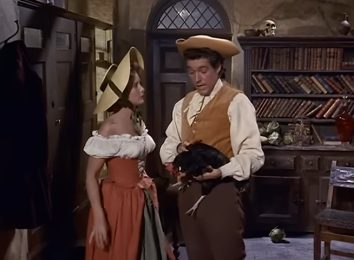
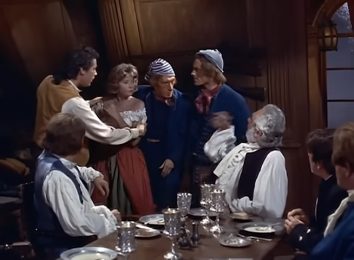
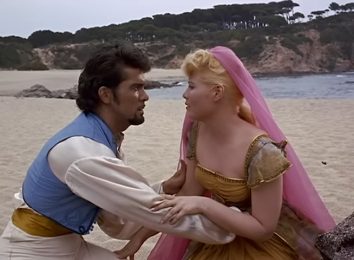

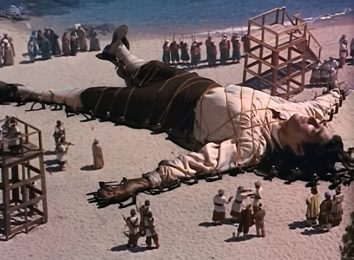





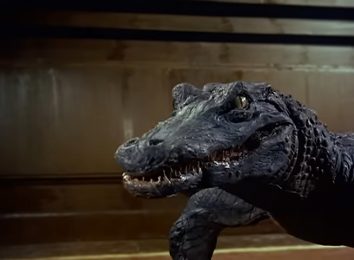

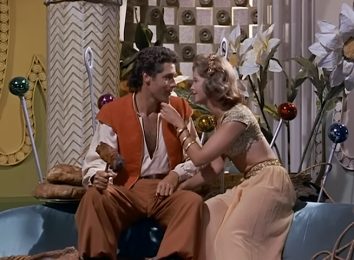
Sounds like a fun movie. I have read the story (I don’t think it was the original), but I don’t remember much. Just the Lilliputian world. And romance is my favourite genre, so adding it to my to-watch list. :))
LikeLiked by 1 person
Oh, don’t watch this for romance. It’s just that instead of the satire, they make the romance a big thing, but it only consists of Gulliver and Elizabeth mooning over each other. No tension, no chemistry, nothing. If you want a good romance, one of my favourites is Bells are Ringing. A musical, perhaps not what one would think of as a romantic film, but I loved it, especially the end. This is what it’s about:
https://madhulikaliddle.com/2009/11/08/bells-are-ringing-1960/
LikeLiked by 1 person
Oh okay. :)) Thank you!
LikeLiked by 1 person
You’re welcome!
BTW: Thank you for recommending Mimi. I watched it last week, and liked it a lot – so heartwarming.
LikeLiked by 1 person
Funny timing this – I JUST got a copy of the 2-part mini-series version of “Gulliver’s Travels” starring Ted Danson (of Cheers fame) and his real-life wife Mary Steenburgen. This version apparently covers all the lands that Gulliver visited. This miniseries is rated very highly by critics. So was planning to watch it this weekend – and saw this post from you.
Sounds like a fun film to add to my list.
LikeLiked by 1 person
Oh, that’s a coincidence indeed! Do let me know how the miniseries turns out, I’d be interested to know. And to watch, if it’s as good as they say it is.
LikeLike
I have always enjoyed the book but have never watched any of the adaptations. Your review makes me curious to watch this.
LikeLike
I hadn’t watched any of the adaptations either, Anu; this was the first (though someone has commented, above, about a mini-series that has been critically acclaimed). This movie is sweet, somewhat geared towards a child rather than anybody who sees the book for what it really is, a satire rather than an adventure.
LikeLike